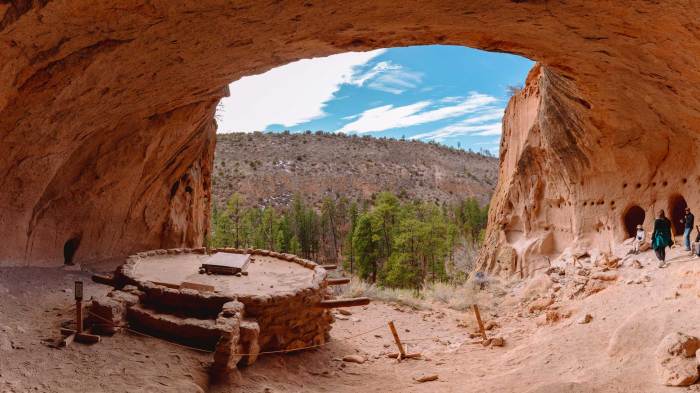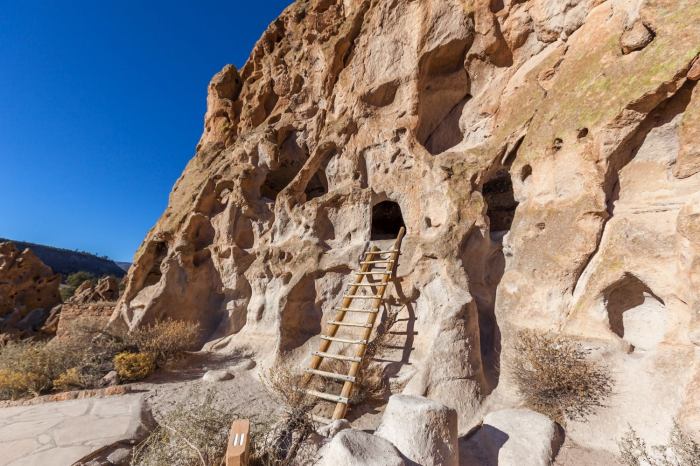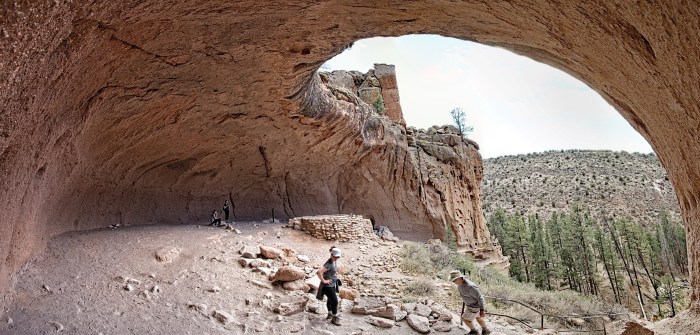Bandelier National Monument, a captivating tapestry of history, culture, and nature, beckons explorers to unravel its secrets. Nestled in the heart of the rugged Jemez Mountains, this enchanting landscape preserves the legacy of the ancient Puebloan people, offering a glimpse into their architectural ingenuity and profound connection to the land.
Beyond its cultural significance, Bandelier boasts a breathtaking natural canvas. Dramatic cliffs, deep canyons, and verdant forests provide a sanctuary for diverse flora and fauna, inviting hikers and nature enthusiasts to immerse themselves in the monument’s pristine beauty.
Bandelier National Monument Overview

Nestled in the rugged terrain of northern New Mexico, Bandelier National Monument preserves the ancestral homelands of the Puebloan people. Established in 1916, the monument encompasses over 33,000 acres of canyons, mesas, and archaeological sites.
The significance of Bandelier lies in its rich cultural heritage and its role as a living laboratory for understanding ancient Puebloan life. The monument’s purpose is to protect and preserve the cultural resources within its boundaries, including over 3,000 archaeological sites and the remnants of ancient dwellings.
Geological and Ecological Features
Bandelier’s geological landscape is characterized by steep-walled canyons carved by the Rio Grande and its tributaries. The area is dominated by volcanic rock formations, including tuff and pumice, which have eroded over time to create the monument’s unique and dramatic topography.
Bandelier National Monument offers a glimpse into the past with its stunning cliff dwellings and petroglyphs. For those planning a trip to Europe, consider purchasing anne frank house tickets to explore the poignant history of the Holocaust. Bandelier National Monument’s unique geological formations and cultural heritage make it a must-visit destination for history and nature enthusiasts alike.
The monument’s ecology is diverse, supporting a wide range of plant and animal life. The canyons provide habitat for various species, including mule deer, black bears, coyotes, and numerous bird species. The vegetation ranges from ponderosa pine forests to piñon-juniper woodlands and riparian areas along the riverbanks.
Bandelier National Monument, nestled in the rugged terrain of New Mexico, invites you to explore its ancient history. Its captivating canyons and evocative ruins tell the story of the Puebloan people who once inhabited this land. Bandelier offers a glimpse into their lives and the rich cultural heritage they left behind.
Cultural Heritage of Bandelier
The ancestral Puebloan people, known as the Anasazi, inhabited Bandelier National Monument for centuries, leaving behind a rich cultural legacy that is evident in the numerous cliff dwellings and petroglyphs found throughout the park. These structures and rock carvings provide valuable insights into the lives and beliefs of these ancient people.
Cliff Dwellings
The cliff dwellings at Bandelier are remarkable examples of Puebloan architecture. Built into the sheer canyon walls, these dwellings provided shelter and protection for the Anasazi people. The dwellings vary in size and complexity, with some containing multiple rooms and others consisting of just a single chamber. The construction techniques used by the Anasazi were highly sophisticated, and the dwellings have withstood the test of time, providing a glimpse into the ingenuity and skill of these ancient builders.
Petroglyphs
In addition to the cliff dwellings, Bandelier is also home to numerous petroglyphs, which are images carved into the rock surfaces. These petroglyphs depict a wide range of subjects, including animals, humans, and geometric designs. They are believed to have served various purposes, such as recording events, communicating messages, and expressing spiritual beliefs. The petroglyphs at Bandelier provide a valuable record of the cultural and artistic traditions of the Anasazi people.
Preservation and Protection
The cultural heritage of Bandelier is of great importance, and significant efforts are made to preserve and protect it. The National Park Service implements strict regulations to minimize the impact of visitors on the cliff dwellings and petroglyphs. Additionally, research and conservation programs are conducted to better understand and protect these cultural resources. Through these efforts, the cultural heritage of Bandelier will continue to be preserved for future generations to appreciate and enjoy.
Hiking and Exploration

Bandelier National Monument offers a network of hiking trails that traverse diverse landscapes, revealing the park’s rich cultural and geological heritage. These trails provide opportunities for visitors to immerse themselves in the park’s natural beauty and explore the remnants of ancient Puebloan settlements.
Scenic Trails and Geological Wonders
The trails wind through dramatic canyons, past towering cliffs, and alongside the meandering Rio Grande. Along the way, hikers encounter a variety of geological formations, including volcanic tuff, sandstone, and limestone. These formations have been shaped by millions of years of erosion, creating a breathtaking landscape.
Responsible Hiking Practices
It is crucial to practice responsible hiking when exploring Bandelier National Monument. Stay on designated trails to protect fragile vegetation and archaeological sites. Carry plenty of water, as the trails can be strenuous in the summer months. Be aware of wildlife and observe them from a distance.
Wildlife Safety
The park is home to a variety of wildlife, including black bears, mountain lions, and coyotes. While these animals are generally not aggressive, it is important to take precautions to ensure safety. Never approach wildlife, and keep food and scented items secured. If you encounter a bear, remain calm and back away slowly.
Educational and Interpretive Programs: Bandelier National Monument

Bandelier National Monument offers a range of educational programs and ranger-led tours to enhance visitors’ understanding of the monument’s natural and cultural history.
The visitor center, located at the park entrance, serves as a hub for educational resources. It features interactive exhibits that explore the geology, ecology, and human history of the area. Visitors can learn about the ancestral Puebloan people who inhabited Bandelier from around 1150 to 1550 CE, as well as the diverse plant and animal life that thrives within the monument.
Bandelier National Monument is a fascinating historical site with a rich cultural heritage. Its significance is comparable to that of antigua guatemala , a UNESCO World Heritage Site known for its well-preserved colonial architecture and vibrant culture. Both destinations offer unique insights into the past and present, making them ideal for history buffs and cultural enthusiasts alike.
Ranger-Led Tours, Bandelier national monument
Ranger-led tours provide an in-depth exploration of Bandelier’s cultural and natural heritage. Guided hikes lead visitors through the monument’s canyons and mesas, offering insights into the lives of the ancestral Puebloans and the unique geology of the region.
Junior Ranger Program
The Junior Ranger Program encourages children and families to explore and learn about Bandelier’s natural and cultural resources. Participants complete activities and learn about the monument’s history, ecology, and geology. Upon completion, junior rangers receive a badge and certificate.
Educational Programs
Bandelier National Monument offers a variety of educational programs throughout the year. These programs include lectures, workshops, and field trips designed to engage visitors of all ages. Topics covered include the history of the ancestral Puebloans, the geology of the region, and the importance of preserving the monument’s natural and cultural resources.
Accessibility and Visitor Information
Bandelier National Monument strives to provide an accessible and enjoyable experience for all visitors.
Accessible features include designated parking spaces, ramps, and accessible restrooms. Visitors with disabilities can also request a wheelchair or scooter at the visitor center. Additionally, sign language interpreters are available upon request.
Entrance Fees, Hours of Operation, and Regulations
The entrance fee for Bandelier National Monument is $25 per vehicle or $15 per person on foot or bicycle. The monument is open daily from 9:00 am to 5:00 pm. Pets are not allowed on trails or in buildings.
Camping, Lodging, and Dining Options
There are no camping facilities within Bandelier National Monument. However, there are several campgrounds and RV parks located nearby. The nearest town, Los Alamos, offers a variety of lodging and dining options.
Final Conclusion

As we bid farewell to Bandelier National Monument, its timeless allure lingers. Its cliff dwellings whisper tales of a bygone era, while its landscapes inspire awe and wonder. Through hiking, educational programs, and respectful exploration, we honor the legacy of the Puebloan people and preserve this extraordinary natural treasure for generations to come.
FAQ Guide
What is the best time to visit Bandelier National Monument?
Spring and fall offer the most pleasant weather for hiking and exploring the monument.
Are pets allowed on the hiking trails?
No, pets are not permitted on the hiking trails within the monument.
Is there camping available within Bandelier National Monument?
Yes, there are several campgrounds within the monument, offering a range of options from primitive to developed sites.